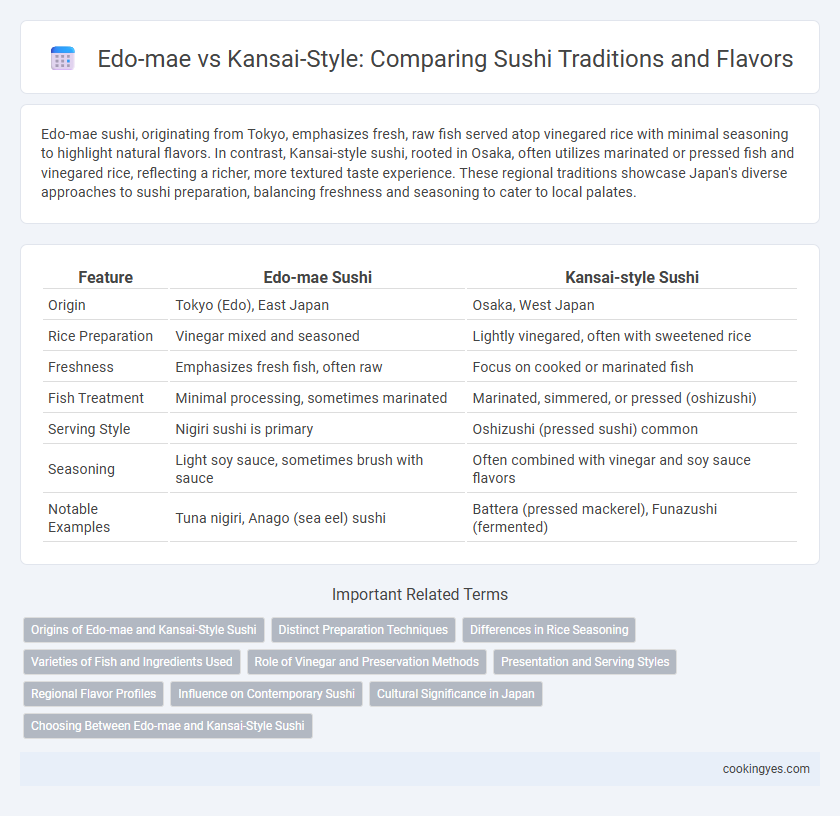Edo-mae sushi, originating from Tokyo, emphasizes fresh, raw fish served atop vinegared rice with minimal seasoning to highlight natural flavors. In contrast, Kansai-style sushi, rooted in Osaka, often utilizes marinated or pressed fish and vinegared rice, reflecting a richer, more textured taste experience. These regional traditions showcase Japan's diverse approaches to sushi preparation, balancing freshness and seasoning to cater to local palates.
Table of Comparison
| Feature | Edo-mae Sushi | Kansai-style Sushi |
|---|---|---|
| Origin | Tokyo (Edo), East Japan | Osaka, West Japan |
| Rice Preparation | Vinegar mixed and seasoned | Lightly vinegared, often with sweetened rice |
| Freshness | Emphasizes fresh fish, often raw | Focus on cooked or marinated fish |
| Fish Treatment | Minimal processing, sometimes marinated | Marinated, simmered, or pressed (oshizushi) |
| Serving Style | Nigiri sushi is primary | Oshizushi (pressed sushi) common |
| Seasoning | Light soy sauce, sometimes brush with sauce | Often combined with vinegar and soy sauce flavors |
| Notable Examples | Tuna nigiri, Anago (sea eel) sushi | Battera (pressed mackerel), Funazushi (fermented) |
Origins of Edo-mae and Kansai-Style Sushi
Edo-mae sushi originated in Tokyo during the Edo period, characterized by fresh fish from Tokyo Bay and a strong emphasis on vinegared rice to enhance flavor and preservation. Kansai-style sushi, originating from the Osaka region, traditionally uses slightly cooked or cured fish, reflecting the local preference for milder, more delicate tastes. These regional differences highlight historical trade routes, local fish availability, and preservation techniques that shaped distinct sushi traditions in Japan.
Distinct Preparation Techniques
Edo-mae sushi, originating from Tokyo, emphasizes curing techniques such as marinating in soy sauce, vinegar, or cooking methods like searing to enhance the fish's flavor and preserve freshness. Kansai-style sushi from Osaka is known for employing pressed sushi (oshizushi) and vinegared rice molded by hand, often incorporating fully cooked or pickled ingredients, reflecting regional preferences. These distinct preparation techniques highlight the cultural and sensory differences between the two traditional sushi styles.
Differences in Rice Seasoning
Edo-mae sushi traditionally uses rice seasoned with a subtle blend of rice vinegar, sugar, and salt, emphasizing a balanced yet slightly tangy flavor that complements fresh seafood. In contrast, Kansai-style sushi employs a sweeter rice seasoning, often incorporating higher sugar content and sometimes mirin, reflecting the region's preference for richer, more pronounced tastes. These differences in rice seasoning highlight the distinct regional approaches to sushi flavor profiles in Japan's Edo (Tokyo) and Kansai areas.
Varieties of Fish and Ingredients Used
Edo-mae sushi, originating from Tokyo, emphasizes fresh fish from Tokyo Bay such as tuna, eel, and sea bream, often marinated or vinegared to enhance flavor. Kansai-style sushi from the Osaka region showcases a wider array of ingredients like mackerel, shrimp, and vinegared vegetables, focusing on pressed sushi (oshizushi) methods. The choice of fish and preparation techniques in each style reflects regional availability and historic preservation practices.
Role of Vinegar and Preservation Methods
Edo-mae sushi, originating from Tokyo, emphasizes vinegar to preserve fish freshness by lightly curing it, reflecting the region's focus on raw fish quality and extended shelf life. Kansai-style sushi, rooted in Osaka, uses vinegared rice with marinated or cooked toppings, highlighting preservation through cooking techniques and stronger vinegar seasoning. The different vinegar applications in each style showcase regional adaptations to climate and seafood availability, influencing texture and flavor profiles.
Presentation and Serving Styles
Edo-mae sushi, originating from Tokyo, emphasizes minimalistic presentation with a focus on delicate seasoning and precise knife work, often served nigiri-style with vinegared rice topped by a single slice of fresh fish. Kansai-style sushi, prevalent in the Osaka region, features more elaborate presentations such as pressed sushi (oshizushi) and rolled sushi (makizushi), where ingredients are layered and compacted for a visually rich and textured experience. Serving styles in Kansai often highlight a balance between flavor and aesthetic arrangement, contrasting Edo-mae's subtle and refined approach to showcasing the natural taste of seafood.
Regional Flavor Profiles
Edo-mae sushi, originating from Tokyo Bay, emphasizes fresh, vinegared rice paired with lightly seasoned fish, often highlighting natural umami and subtle sweetness from soy sauce and wasabi. Kansai-style sushi, rooted in the Osaka region, distinguishes itself with preserved and cured ingredients like vinegar-marinated mackerel or prawn, delivering bolder, tangier flavor profiles that reflect historical preservation methods. These regional flavor profiles showcase Japan's diverse culinary traditions through specific fish treatments and seasoning techniques, offering distinct tasting experiences in sushi culture.
Influence on Contemporary Sushi
Edo-mae sushi, originating from Tokyo, emphasizes fresh, vinegared rice paired with raw fish, influencing contemporary sushi by prioritizing simplicity and highlighting natural flavors. Kansai-style sushi, from the Osaka region, uses pressed or cooked fish and often incorporates slightly sweeter rice, enhancing the diversity of modern sushi textures and tastes. The interplay between Edo-mae's subtle freshness and Kansai's robust preparation techniques shapes today's fusion sushi, blending tradition with innovation.
Cultural Significance in Japan
Edo-mae sushi, originating from Tokyo, showcases fresh, vinegared rice paired with raw fish, symbolizing Edo's maritime heritage and urban sophistication. Kansai-style sushi, especially Osaka's pressed sushi (oshizushi), reflects the region's culinary emphasis on preserved ingredients and artistic presentation, deeply rooted in the historical trade routes of western Japan. These sushi traditions embody regional identities and cultural values, highlighting Japan's diverse gastronomic history.
Choosing Between Edo-mae and Kansai-Style Sushi
Edo-mae sushi emphasizes fresh, raw fish with a slightly vinegared rice base originating from Tokyo, known for its simplicity and subtle flavors. Kansai-style sushi, rooted in Osaka, often features pressed or vinegared seafood with sweeter, more seasoned rice, creating a richer taste profile. Choosing between Edo-mae and Kansai-style sushi depends on preference for delicate freshness versus bold, marinated flavors unique to their regional traditions.
Edo-mae vs Kansai-style for sushi tradition Infographic

 cookingyes.com
cookingyes.com